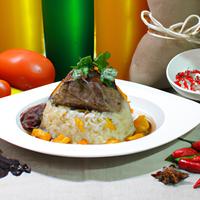
1 serving (200 grams) contains 300 calories, 15.0 grams of protein, 10.0 grams of fat, and 40.0 grams of carbohydrates.

Log this food in SnapCalorie

Nutrition Information
Calories |
352.9 | ||
|---|---|---|---|
% Daily Value* |
|||
| Total Fat | 11.8 g | 15% | |
| Saturated Fat | 3.5 g | 17% | |
| Polyunsaturated Fat | 0 g | ||
| Cholesterol | 35.3 mg | 11% | |
| Sodium | 588.2 mg | 25% | |
| Total Carbohydrates | 47.1 g | 17% | |
| Dietary Fiber | 2.4 g | 8% | |
| Sugars | 1.2 g | ||
| protein | 17.6 g | 35% | |
| Vitamin D | 0 mcg | 0% | |
| Calcium | 23.5 mg | 1% | |
| Iron | 2.4 mg | 13% | |
| Potassium | 235.3 mg | 5% | |
* Percent Daily Values are based on a 2,000 calorie diet. Your daily values may be higher or lower depending on your calorie needs.
Food Attributes
Source of Calories
About Rice and meat
Rice and meat is a versatile dish enjoyed across various cuisines worldwide, including Asian, Middle Eastern, Latin American, and African traditions. It typically combines cooked rice, a staple high in carbohydrates, with a protein-rich meat such as chicken, beef, lamb, or pork. Additional ingredients like vegetables, herbs, and spices vary by culture, adding flavor and nutrients. This dish can provide a balanced meal, with rice offering energy and fiber and meat supplying essential proteins, vitamins, and minerals like iron and zinc. However, the healthiness of rice and meat depends on preparation methods. Lean cuts of meat and whole-grain rice contribute to a healthier profile, while processed meats and excessive fats or oils may increase saturated fat and calorie content. Moderation and serving size are key to enjoying this hearty dish as part of a nutritious diet.



